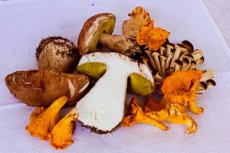
All iLive content is medically reviewed or fact checked to ensure as much factual accuracy as possible.
We have strict sourcing guidelines and only link to reputable media sites, academic research institutions and, whenever possible, medically peer reviewed studies. Note that the numbers in parentheses ([1], [2], etc.) are clickable links to these studies.
If you feel that any of our content is inaccurate, out-of-date, or otherwise questionable, please select it and press Ctrl + Enter.
Mushrooms in type 1 and type 2 diabetes mellitus
Medical expert of the article
Last reviewed: 04.07.2025

Diabetes mellitus requires a special dietary pattern, which significantly limits carbohydrate consumption. This is due to a disorder (type 2) or lack (type 1) of insulin synthesis, a hormone produced by the pancreas and responsible for the absorption of glucose by the body's cells. When organizing nutrition, it is important to know the glycemic index (GI) of each product. Preference is given to those with a low GI (up to 40 U). What do mushrooms look like from this point of view and can they be eaten with diabetes types 1 and 2?
Benefits and harms
Mushrooms are unique organisms, without which it is difficult to imagine living nature. They are an integral part of the ecosystem, as they contribute to the decomposition of all organic matter remaining after the death of animals and plants. They are involved in the production of medicines and drugs. Edible mushrooms have great nutritional value and are actively used in cooking. For patients with diabetes, they are a desirable food product, as they have a low GI, a lot of fiber, vitamins A, B, B2, D, C, PP, minerals: potassium, phosphorus, iron, calcium, magnesium, etc.
However, do not forget that this is quite a heavy food for the digestive organs, pancreas, so it is worth limiting their consumption to 100g per week, and not all methods of their preparation are suitable. In case of exacerbation of gastritis, gastroduodenitis, pancreatitis, mushrooms can cause harm to health.


 [
[